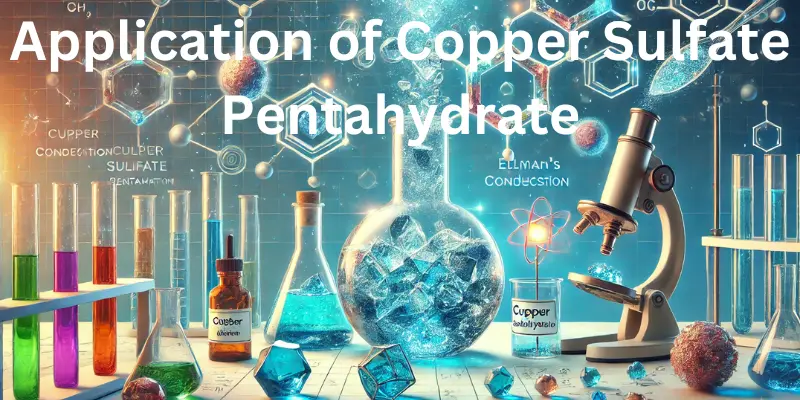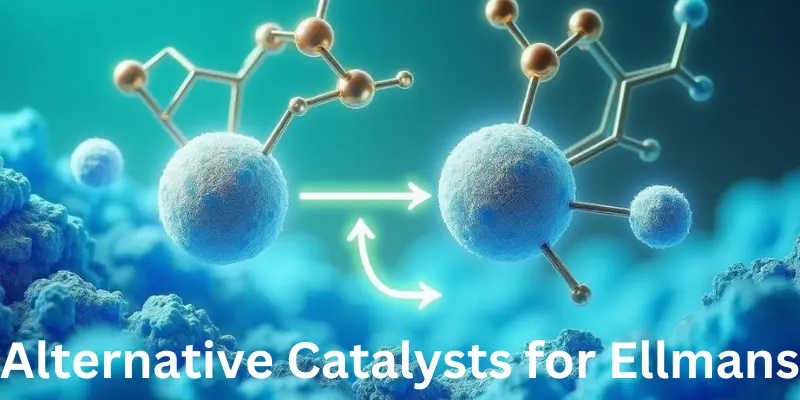Have you ever wondered how scientists create medicines or special materials? Well, they often use different reactions, which are like little “recipes” in chemistry. One of these reactions is called Ellman’s condensation. It’s a fancy way of saying a reaction that helps connect tiny building blocks, especially ones with sulfur (a special element you find in many important chemicals). Pentahydrate for Ellmans Condensation
Now, there’s a helper that scientists sometimes use for this reaction called copper sulfate pentahydrate. Don’t worry if it sounds complicated! Let’s break it down: “pentahydrate” just means it has water in its structure (five molecules of water, to be exact), and “copper sulfate” is a common chemical that’s bright blue in color.
This helper chemical can sometimes make reactions go faster or make them work better, like a superpower for scientists working on Ellman’s reaction. In this way, it’s sort of like a cooking ingredient that adds flavor or helps a recipe turn out just right. In our exploration, we’ll look at how copper sulfate pentahydrate works in Ellman’s reaction and why it’s important for making things like medicines and other useful products.
Table of Contents
What is Pentahydrate for Ellmans Condensation
In chemistry, pentahydrate is a type of chemical that has five water molecules attached to it. Think of it as a group of tiny water buddies that stick to another substance, helping it behave in a certain way in chemical reactions. One common example is copper sulfate pentahydrate. This is a blue-colored powder that chemists often use because of its helpful properties.
Now, on to Ellman’s reaction. This is a process used in labs, mostly by scientists, to create something called a disulfide bond. A disulfide bond is like a little bridge that connects molecules. These bridges are super important for making certain types of medicines and materials.
You May Also Visit It:
Why is this Useful?
Ellman’s condensation is important because it helps create molecules that are useful in medicine and science. For example, it’s used to make certain drugs, materials, and even some things found in plants or animals. Scientists like this reaction because it’s reliable and usually creates the product they want without too many extra steps.
In short, Ellman’s condensation is like a handy tool that helps scientists “glue” molecules together using sulfur. By understanding how to use this reaction, they can make all sorts of useful substances!
Understanding Pentahydrate for Ellmans Condensation
Ellman’s condensation might sound like a complicated scientific term, but it’s really just a chemical reaction that scientists use to join certain types of molecules together. Think of it like making a sandwich you take two slices of bread (the molecules you want to join) and stick them together with some filling (a chemical bond). In Ellman’s condensation, the “filling” is a bond that connects two sulfur atoms.
Here’s how it works in simple steps:
- Starting Ingredients: Scientists start with molecules that contain sulfur. Sulfur is an element, just like oxygen or carbon, but it has special properties that make it good for connecting things in a reaction.
- Adding a Helper: To make the reaction happen, scientists use something called a catalyst. This is a substance that helps the reaction go faster or happen more easily, a bit like heating ingredients to speed up cooking.
- Creating the Bond: When the catalyst is added, it helps create a bond between two sulfur atoms in different molecules. This bond is strong and helps the molecules stick together to form a new, bigger molecule.
The Role of Catalysts in Pentahydrate for Ellmans Condensation
Ellman’s condensation might sound like a tricky term, but let’s break it down in a simple way! In chemistry, a reaction happens when different substances mix and change into new ones. Sometimes, we need a little help to make that change happen faster or more easily. That’s where catalysts come in!
Think of a catalyst like a helper or a tool that makes a process faster without getting used up in the end. It’s like when you use a can opener to open a can you are helping the can open faster, but the opener stays the same. In the case of Ellman’s condensation, a catalyst helps two chemicals (called thiols) join together to form a new substance (called a thioether) in a quick and efficient way.
- Save time: Reactions happen much faster.
- Use less energy: We don’t need to heat things up a lot or use harsh conditions.
- Be more efficient: Catalysts help get the job done well and quickly.
Application of Copper Sulfate Pentahydrate for Ellmans Condensation

Ellman’s condensation is a special chemical reaction used to create certain types of bonds, which are like the “glue” between molecules. One of the ways to make this reaction happen is by using a substance called copper sulfate pentahydrate. It sounds complicated, but let’s break it down!
Copper sulfate pentahydrate is a type of salt made from copper. It’s often used in different chemistry experiments because it helps speed up reactions. In Ellman’s condensation, it works like a helper that makes the reaction happen more easily and quickly.
Advantages
- Copper sulfate pentahydrate is a catalyst. This means it speeds up the chemical reaction without being used up itself. It helps the reaction happen more quickly, which is useful when scientists need to make something faster.
- Copper sulfate pentahydrate can work well in the Ellman’s condensation reaction without needing super high heat or pressure. This makes it easier to use in experiments because it doesn’t need special equipment or dangerous conditions.
- In some cases, copper sulfate pentahydrate can be a great choice for helping the reaction create the product needed. It’s useful when creating certain types of bonds, like thioethers, which are important in making medicines and other useful chemicals.
Limitations and Considerations
1. Doesn’t Always Work Perfectly
Even though copper sulfate pentahydrate can help, it doesn’t always work well for every kind of reaction. Sometimes it might not be the best choice, and other chemicals might work better. For example, in some reactions, copper sulfate pentahydrate can cause side effects that make the reaction not go as planned.
2. May Cause Unwanted Side Effects
If the reaction isn’t carefully controlled, copper sulfate pentahydrate might lead to unwanted side reactions. This means that it can create chemicals that weren’t supposed to be made, which can mess up the whole process.
3. Not Always the Greenest Option
While copper sulfate pentahydrate is helpful, it’s not the most eco-friendly option out there. Some researchers are looking for more sustainable ways to do the same reactions with fewer harmful effects on the environment.
You May Also Visit It:
Alternative Catalysts of Pentahydrate for Ellmans Condensation

Ellman’s condensation is a special reaction used in chemistry, and it needs a catalyst to work better. A catalyst is like a helper that speeds up a chemical reaction without getting used up itself. While copper sulfate pentahydrate is one option, there are other catalysts scientists use for Ellman’s condensation, and they each have their own strengths.
Here are some other catalysts that can help in Ellman’s condensation:
1. Sodium Hydroxide (NaOH)
This is a type of strong base, which helps to break apart other chemicals so they can react. It’s commonly used in many chemical reactions, including Ellman’s condensation.
- Why it’s good: It works well to get the reaction going and is easy to use.
- Downside: It can sometimes be too harsh and cause unwanted side effects if not handled carefully.
2. Potassium Carbonate (K2CO3)
Like sodium hydroxide, potassium carbonate is another base used in many reactions. It works by helping to remove certain parts from molecules, allowing them to combine in a new way.
- Why it’s good: It’s a bit milder than sodium hydroxide, so it might be better for some reactions.
- Downside: It may not be as fast as other catalysts in some cases.
3. Palladium on Carbon (Pd/C)
This catalyst is made by putting palladium, a type of metal, onto a surface of carbon. It’s often used in reactions that involve adding new parts to molecules (like making new bonds).
- Why it’s good: Palladium is great at helping reactions happen quickly and efficiently.
- Downside: It’s more expensive and harder to work with compared to simpler options like sodium hydroxide.
4. Ionic Liquids
These are special liquids that don’t evaporate easily, and they can act as a catalyst in some reactions. They’re often used because they are very good at dissolving different chemicals.
- Why it’s good: They are more eco-friendly because they don’t pollute as easily as other chemicals.
- Downside: They can be more expensive and need special care to handle.
5. Nickel-based Catalysts
Nickel, another metal, is sometimes used for these kinds of reactions. It’s usually combined with other chemicals to make a strong catalyst.
- Why it’s good: Nickel catalysts are cheaper than palladium and still very effective.
- Downside: Like palladium, nickel needs careful handling to avoid mistakes in the reaction.
Tips for Better Results
When you’re doing experiments with copper sulfate pentahydrate for Ellman’s condensation, there are a few helpful tips that can make your work easier and more successful:
1. Check the Right Conditions
Before you start, make sure you understand the right temperature and solvent conditions. Copper sulfate pentahydrate works best when the reaction is at the right temperature and in the right liquid (like water or a specific solvent). Too hot or too cold, and it might not work as well. So, always double-check the instructions!
2. Start Small
When you first try using copper sulfate pentahydrate, don’t use a lot of it. Start with a small amount to see how it behaves. That way, if things go wrong, you won’t waste too much material. Chemistry is all about experimenting!
3. Watch for Color Changes
Copper sulfate pentahydrate is blue. If the color changes during the reaction, that’s a sign something is happening! Pay attention to these color shifts, as they can help you understand if the reaction is going well or if something went wrong.
4. Use a Base
In Ellman’s condensation, you usually need a base like sodium hydroxide (NaOH) or potassium carbonate (K2CO3) to make the reaction work. The base helps activate the copper sulfate pentahydrate so it can do its job. Don’t forget this step—it’s super important!
5. Check for Other Catalysts
Copper sulfate pentahydrate isn’t the only option. If you want to experiment further, you can try using other catalysts, like palladium or nickel, to see if they give you better results. It’s all about finding the best one for your reaction!
FAQs about Pentahydrate for Ellmans Condensation
1. What is Pentahydrate for Ellmans Condensation
Ellman’s Condensation is a special chemistry reaction where two molecules combine to make a new one. It’s often used to create compounds that have sulfur in them, like in some medicines or other useful chemicals.
2. What is Copper Sulfate Pentahydrate?
Copper sulfate pentahydrate is a type of chemical that contains copper and water. It’s used in science labs to help other reactions happen faster. It looks like blue crystals when it’s dry and is often used to make certain reactions go more smoothly.
3. Can Copper Sulfate Pentahydrate for Ellmans Condensation
Yes, copper sulfate pentahydrate can be used to help speed up the Ellman’s Condensation reaction. It acts as a catalyst, which means it helps the reaction happen faster without getting used up itself.
4. Why Do Scientists Use Copper Sulfate Pentahydrate in Reactions?
Scientists use it because it helps other chemicals react without needing super high temperatures or special equipment. It’s a useful tool in chemistry for making new compounds!
5. Are There Other Chemicals That Can Be Used Pentahydrate for Ellmans Condensation?
Yes, there are other chemicals that can also help with Ellman’s Condensation, like palladium or nickel. These are often used in place of copper sulfate, depending on what kind of reaction scientists want to do.
6. Can Copper Sulfate Pentahydrate Be Used in Everyday Life?
Copper sulfate pentahydrate is mostly used in labs and not really in everyday life. But it can be found in some products like fertilizers or even in the chemicals that help clean swimming pools!
7. What is a Catalyst?
A catalyst is a substance that helps a chemical reaction happen faster but isn’t changed by the reaction. It’s like a helper that speeds things up without getting used up!
8. Why Do We Need Reactions Like Ellman’s Condensation?
These reactions are important because they help create new chemicals that can be used in medicine, cleaning products, and other important things. Without these reactions, we wouldn’t have some of the useful products we use every day!
Conclusion
In the end, copper sulfate pentahydrate might not be the most common choice for Ellman’s condensation, but it can still be useful in some situations. It helps with certain chemical reactions, making them easier to perform. However, like all things in science, it’s important to remember that different reactions might need different tools. While copper sulfate pentahydrate is a good option for some experiments, other catalysts might work better depending on what you’re trying to achieve.
So, if you’re doing an experiment or working on a chemistry project, don’t forget to explore all your options. Keep learning and experimenting, and who knows you might even discover new ways to use things like copper sulfate pentahydrate in fun and creative ways.
Bonus Points on Pentahydrate and Ellmans Condensation
- Pentahydrate:
- The word “Pentahydrate” sounds fancy, but it just means a chemical that has five water molecules attached to it.
- The “penta” part means five, and “hydrate” means it has water.
- These water molecules help keep the chemical stable and give it certain useful properties.
- Fun fact: If you heat a pentahydrate, the water can evaporate, changing the way the chemical looks and behaves.
- Ellman’s Condensation:
- Ellman’s Condensation is a special reaction used by scientists to build or join certain molecules together.
- Think of it like using building blocks to create a new shape, but with molecules.
- This reaction is helpful in making different chemicals, especially ones used in medicines and research.
- It was named after a scientist named Ellman who figured out how to do this reaction in a simple way.
You May Also Visit It:










